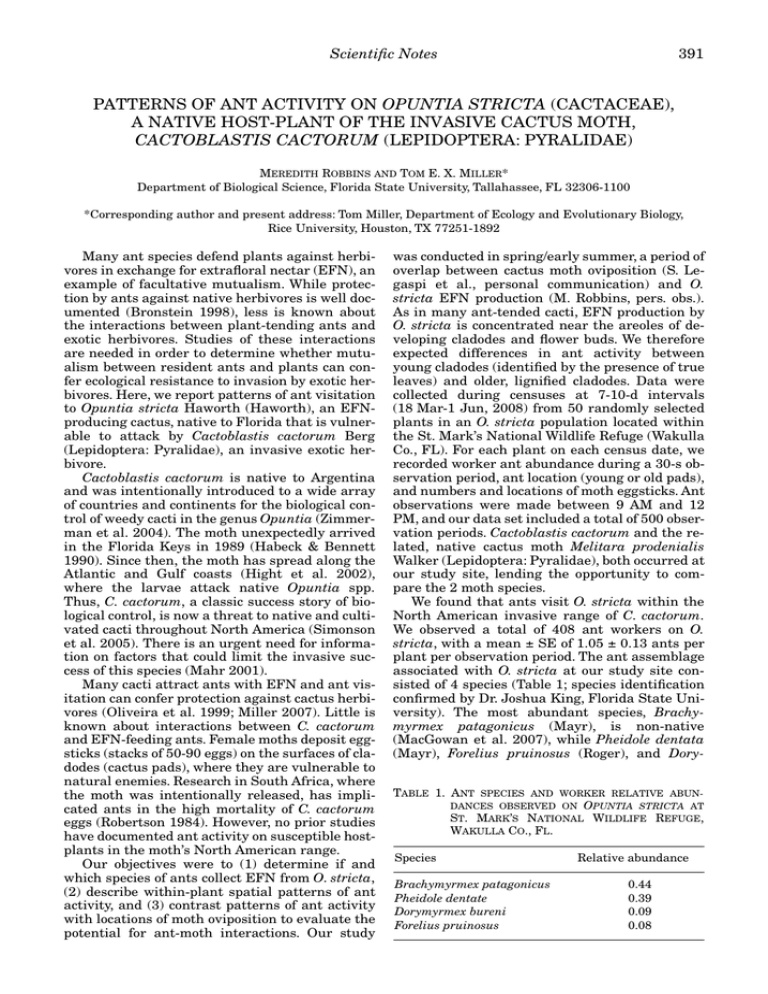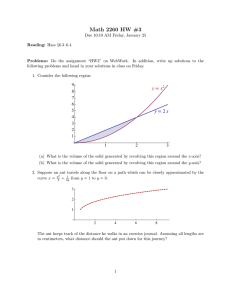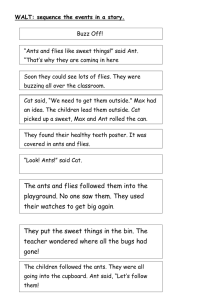patterns of ant activity on opuntia stricta (cactaceae)
advertisement

Scientific Notes 391 PATTERNS OF ANT ACTIVITY ON OPUNTIA STRICTA (CACTACEAE), A NATIVE HOST-PLANT OF THE INVASIVE CACTUS MOTH, CACTOBLASTIS CACTORUM (LEPIDOPTERA: PYRALIDAE) MEREDITH ROBBINS AND TOM E. X. MILLER* Department of Biological Science, Florida State University, Tallahassee, FL 32306-1100 *Corresponding author and present address: Tom Miller, Department of Ecology and Evolutionary Biology, Rice University, Houston, TX 77251-1892 Many ant species defend plants against herbivores in exchange for extrafloral nectar (EFN), an example of facultative mutualism. While protection by ants against native herbivores is well documented (Bronstein 1998), less is known about the interactions between plant-tending ants and exotic herbivores. Studies of these interactions are needed in order to determine whether mutualism between resident ants and plants can confer ecological resistance to invasion by exotic herbivores. Here, we report patterns of ant visitation to Opuntia stricta Haworth (Haworth), an EFNproducing cactus, native to Florida that is vulnerable to attack by Cactoblastis cactorum Berg (Lepidoptera: Pyralidae), an invasive exotic herbivore. Cactoblastis cactorum is native to Argentina and was intentionally introduced to a wide array of countries and continents for the biological control of weedy cacti in the genus Opuntia (Zimmerman et al. 2004). The moth unexpectedly arrived in the Florida Keys in 1989 (Habeck & Bennett 1990). Since then, the moth has spread along the Atlantic and Gulf coasts (Hight et al. 2002), where the larvae attack native Opuntia spp. Thus, C. cactorum, a classic success story of biological control, is now a threat to native and cultivated cacti throughout North America (Simonson et al. 2005). There is an urgent need for information on factors that could limit the invasive success of this species (Mahr 2001). Many cacti attract ants with EFN and ant visitation can confer protection against cactus herbivores (Oliveira et al. 1999; Miller 2007). Little is known about interactions between C. cactorum and EFN-feeding ants. Female moths deposit eggsticks (stacks of 50-90 eggs) on the surfaces of cladodes (cactus pads), where they are vulnerable to natural enemies. Research in South Africa, where the moth was intentionally released, has implicated ants in the high mortality of C. cactorum eggs (Robertson 1984). However, no prior studies have documented ant activity on susceptible hostplants in the moth’s North American range. Our objectives were to (1) determine if and which species of ants collect EFN from O. stricta, (2) describe within-plant spatial patterns of ant activity, and (3) contrast patterns of ant activity with locations of moth oviposition to evaluate the potential for ant-moth interactions. Our study was conducted in spring/early summer, a period of overlap between cactus moth oviposition (S. Legaspi et al., personal communication) and O. stricta EFN production (M. Robbins, pers. obs.). As in many ant-tended cacti, EFN production by O. stricta is concentrated near the areoles of developing cladodes and flower buds. We therefore expected differences in ant activity between young cladodes (identified by the presence of true leaves) and older, lignified cladodes. Data were collected during censuses at 7-10-d intervals (18 Mar-1 Jun, 2008) from 50 randomly selected plants in an O. stricta population located within the St. Mark’s National Wildlife Refuge (Wakulla Co., FL). For each plant on each census date, we recorded worker ant abundance during a 30-s observation period, ant location (young or old pads), and numbers and locations of moth eggsticks. Ant observations were made between 9 AM and 12 PM, and our data set included a total of 500 observation periods. Cactoblastis cactorum and the related, native cactus moth Melitara prodenialis Walker (Lepidoptera: Pyralidae), both occurred at our study site, lending the opportunity to compare the 2 moth species. We found that ants visit O. stricta within the North American invasive range of C. cactorum. We observed a total of 408 ant workers on O. stricta, with a mean ± SE of 1.05 ± 0.13 ants per plant per observation period. The ant assemblage associated with O. stricta at our study site consisted of 4 species (Table 1; species identification confirmed by Dr. Joshua King, Florida State University). The most abundant species, Brachymyrmex patagonicus (Mayr), is non-native (MacGowan et al. 2007), while Pheidole dentata (Mayr), Forelius pruinosus (Roger), and DoryTABLE 1. ANT SPECIES AND WORKER RELATIVE ABUNDANCES OBSERVED ON OPUNTIA STRICTA AT ST. MARK’S NATIONAL WILDLIFE REFUGE, WAKULLA CO., FL. Species Brachymyrmex patagonicus Pheidole dentate Dorymyrmex bureni Forelius pruinosus Relative abundance 0.44 0.39 0.09 0.08 392 Florida Entomologist 92(2) myrmex bureni (Trager) are native to the Southeast U.S. All species except F. pruinosus were observed collecting nectar from cactus extra-floral nectaries. We compared the within-plant distribution of ants with the expected distribution based on numbers of young and old cladodes on our study plants. Pooled across species, ants occurred more frequently on young cladodes, where extrafloral nectaries are located, than expected by chance (Fisher’s Exact test: P < 0.001). Thus, young cladodes may be better defended than old ones. However, partitioning the data by ant species revealed interesting differences (Fig. 1A). The two most abundant species, B. patagonicus and P. dentata, occurred most frequently on young cladodes (Fisher’s Exact tests: P < 0.001, P < 0.002), respectively, while F. pruinosus did not deviate from the random expectation (P = 0.68); we did not have sufficient data for similar analysis of D. bureni. Both C. cactorum and M. prodenialis deposited eggsticks on our study plants. As above, we compared the locations of eggsticks to the null expectation. This analysis included a total of 15 C. cactorum and 27 M. prodenialis eggsticks. Eggsticks from C. cactorum eggsticks occurred on old vs. young cladodes more frequently than expected (Fig. 1B), though the deviation was only marginally significant (Fisher’s Exact test: P = 0.08). In contrast, M. prodenialis eggsticks occurred most often on young cladodes, where overall ant activity was greatest (P < 0.001; Fig. 1B). These data do not indicate whether the difference in eggstick June 2009 occurrence between the invasive and native moths reflects a difference in female oviposition preference or a difference in post-oviposition egg removal/predation. However, a separate study showed that eggstick survival rates were equal on young and old cladodes (Miller, unpublished data), and so we suspect that the difference in occurrence reflects a difference in female preference. The ant activity on O. stricta documented here indicates potential for resident ants to act as plant mutualists and limit the success of C. cactorum. However, at least 3 factors might influence the effectiveness of ants as agents of ecological resistance. First, the combination of ant and moth occurrence data suggests that the low overall ant activity on old cladodes may provide a spatial refuge for successful C. cactorum oviposition and egg development. In fact, our data suggest that ants may be more likely to encounter the native moth than the invasive moth. Second, ant species differed in their relative abundances and frequencies of occurrence on young versus old cladodes. Consequently, C. cactorum and M. prodenialis may interact with different subsets of the cactustending ant assemblage. Our results indicate a need for experimental studies that quantify variation among ant species in their protective abilities and the net effects of ant visitation on C. cactorum population growth. Finally, C. cactorum is known to have 3 oviposition periods per year: Apr, Aug, and Oct (S. Legaspi et al., personal communication). Our observations suggest that EFN Fig. 1. Relative frequencies of (A) ant workers and (B) moth eggsticks on young (black) and old (white) Opuntia stricta cladodes, compared to the expected frequencies based on cladode relative abundance. Stars indicate deviations from expected frequencies based on Fisher’s Exact tests (*P < 0.1, **P < 0.001). Scientific Notes production by O. stricta is seasonal, with a peak during the Apr oviposition period. Thus, if ant activity is motivated by EFN, then 2 of the 3 cactus moth generations per year may have limited interactions with ants. Given the threats posed by C. cactorum, further investigations into these sources of variation in ant-plant-moth interactions are warranted. SUMMARY We present evidence for interactions between cacti and cactus-tending ants within the invasive range of C. cactorum. There is potential for antplant mutualism to limit the success of this invasive herbivore. However, significant within-plant variation in both ant and moth activity may influence the frequencies and outcomes of ant-moth interactions. This study lays the groundwork for subsequent research on ant-cactus interactions that could contribute to control strategies against C. cactorum. REFERENCES CITED BRONSTEIN, J. L. 1998. The contribution of ant-plant protection studies to our understanding of mutualism. Biotropica 30: 150-161. HABECK, D. H., AND BENNETT, F. D. 1990. Cactoblastis cactorum Berg (Lepidoptera: Pyralidae), A Phycitine New to Florida. Entomology Circular 333, Florida Dept. Agric. Consumer Services, Div. Plant Industries. HIGHT, S. D., CARPENTER, J. E., BLOEM, K. A., BLOEM, S., PEMBERTON, R. W., AND STILING, P. 2002. Ex- 393 panding geographic range of Cactoblastis cactorum (Lepidoptera: Pyralidae) in North America. Florida Entomol. 85: 527-529. MACGOWAN, J. A., HILL, J. G., AND DEYRUP, M. A. 2007. Brachymyrmex patagonicus (Hymenoptera: Formicidae), an emerging pest species in the southeastern United States. Florida Entomol. 90: 457-464. MAHR, D. L. 2001. Cactoblastis cactorum (Lepidoptera: Pyralidae) in North America: a workshop of assessment and planning. Florida Entomol. 84: 465-473. MILLER, T. E. X. 2007. Does having multiple partners weaken the benefits of facultative mutualism? A test with cacti and cactus-tending ants. Oikos 116: 500512. OLIVEIRA, P. S., RICO-GRAY, V., DIEZ-CASTELAZO, C., AND CASTILLO-GUEVARA, C. 1999. Interactions between ants, extrafloral nectaries, and insect herbivores in Neotropical sand dunes: herbivore deterrence by visiting ants increases fruit set in Opuntia stricta (Cactaceae). Functional Ecol. 13: 623-631. ROBERTSON, H. G. 1984. Egg predation by ants as a partial explanation of the difference in performance of Cactoblastis cactorum on cactus weeds in South Africa and Australia, pp. 83-88 In Proc. VI Symp. Biol. Contr. Weeds, Vancouver. SIMONSON, S. E., STOHLGREN, T. J., TYLER, L., GREGG, W. P., MUIR, R., AND GARRETT, L. J. 2005. Preliminary assessment of the potential impacts and risks of the invasive cactus moth, Cactoblastis cactorum Berg, in the U.S. and Mexico. Intl. Atomic Energy Agency, Vienna, Austria. ZIMMERMAN, H. G., BLOEM, S., AND KLEIN, H. 2004. Biology, history, threat, surveillance and control of the cactus moth, Cactoblastis cactorum, pp xxx In Joint FAO/IAEA Programme of Nuclear Techniques in Food and Agriculture. IAEA, Vienna, Austria.




